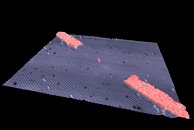- Joined
- Oct 9, 2007
- Messages
- 47,511 (7.48/day)
- Location
- Hyderabad, India
| System Name | RBMK-1000 |
|---|---|
| Processor | AMD Ryzen 7 5700G |
| Motherboard | ASUS ROG Strix B450-E Gaming |
| Cooling | DeepCool Gammax L240 V2 |
| Memory | 2x 8GB G.Skill Sniper X |
| Video Card(s) | Palit GeForce RTX 2080 SUPER GameRock |
| Storage | Western Digital Black NVMe 512GB |
| Display(s) | BenQ 1440p 60 Hz 27-inch |
| Case | Corsair Carbide 100R |
| Audio Device(s) | ASUS SupremeFX S1220A |
| Power Supply | Cooler Master MWE Gold 650W |
| Mouse | ASUS ROG Strix Impact |
| Keyboard | Gamdias Hermes E2 |
| Software | Windows 11 Pro |
A team of scientists at the ARC Centre for Quantum Computation and Communication, at the University of New South Wales (UNSW), unveiled a fully functional single-atom transistor, which they predict will go on to become a critical building block of tomorrow's high-performance computing devices. The new transistor design was described in a paper, published by Nature. The active component of this transistor is a single phosphorous atom patterned between atomic-scale electrodes and control gates.
Single atom transistor designs have been attempted in the past, but those designs have had an error of about 10 nanometres in positioning of the atoms, which is big enough to affect their functionality. Professor Michelle Simmons, group leader of this study, said that this is the first time "anyone has shown control of a single atom in a substrate with this level of precise accuracy," adding that "Several groups have tried this, but if you want to make a practical computer in the long-term you need to be able to put lots of individual atoms in."

A video presentation by the group follows.
View at TechPowerUp Main Site
Single atom transistor designs have been attempted in the past, but those designs have had an error of about 10 nanometres in positioning of the atoms, which is big enough to affect their functionality. Professor Michelle Simmons, group leader of this study, said that this is the first time "anyone has shown control of a single atom in a substrate with this level of precise accuracy," adding that "Several groups have tried this, but if you want to make a practical computer in the long-term you need to be able to put lots of individual atoms in."

A video presentation by the group follows.
View at TechPowerUp Main Site


 researchers.
researchers. 


 . On topic though, hardly we will get there so fast
. On topic though, hardly we will get there so fast 





